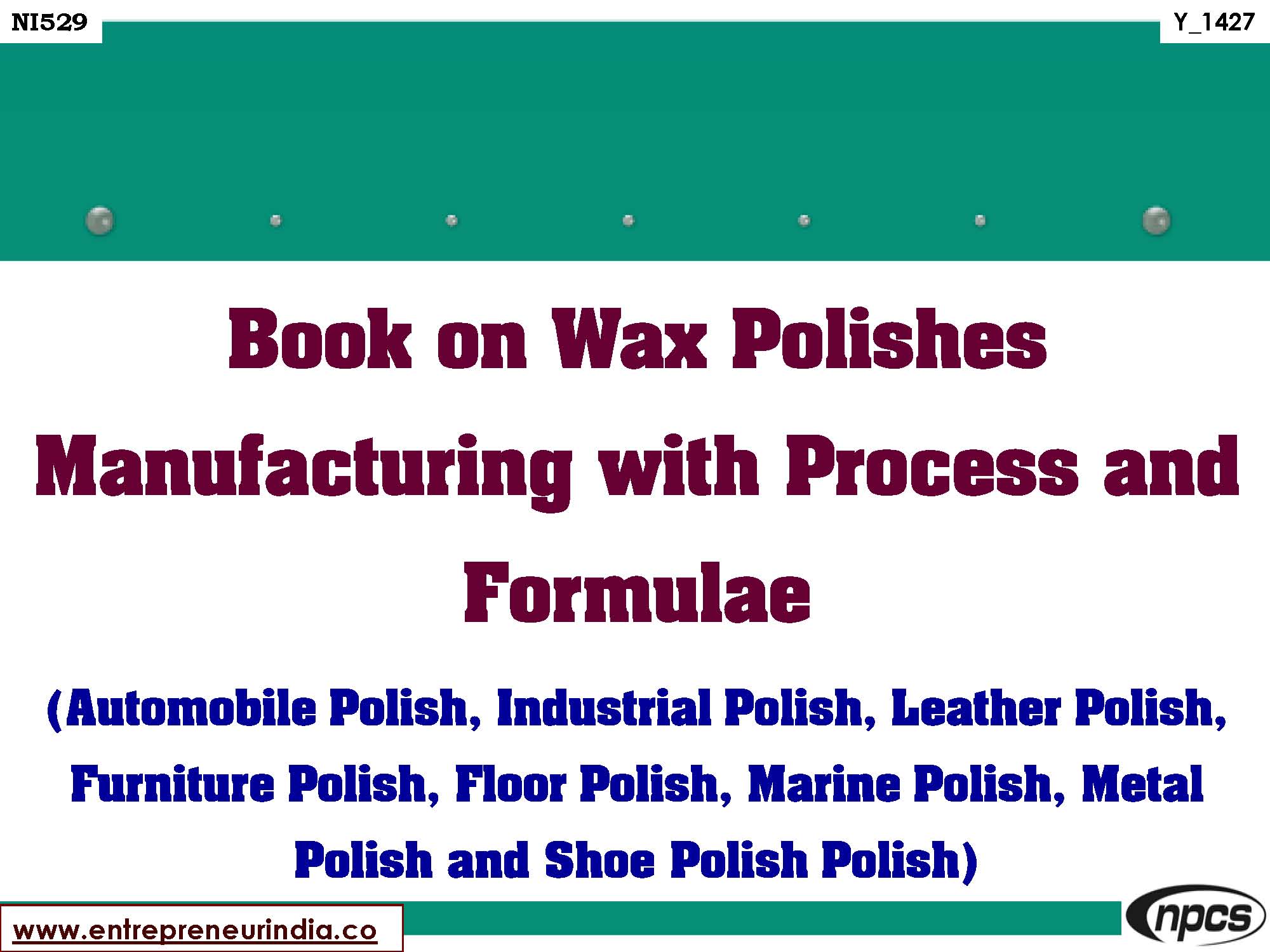
Wax Polishes Manufacturing with Process and Formulae is a rewarding business opportunity in the chemical and homecare product industry. Wax polishes are widely used for polishing furniture, automobiles, footwear, floors, and metallic surfaces to enhance their shine, protect surfaces, and repel dust or moisture. With increasing demand across industrial and domestic segments, starting a wax polish manufacturing unit offers high margins, low startup costs, and the ability to scale with customized product lines. The key to success in this segment lies in mastering the right formulae, process techniques, and quality control standards for consistent product performance.
Overview of Wax Polish Types and Applications
Wax polishes are available in various types based on their application. The most popular include furniture polish, shoe polish, car wax, floor polish, and metal polish. They can be solvent-based, water-based, or emulsion-based depending on the desired finish and drying time.
In furniture and shoe polish, the goal is to enhance gloss and create a protective layer. Car waxes and bike polishes, often formulated with carnauba or synthetic polymers, provide UV protection and water beading. Floor polishes aim for durability and anti-slip finishes, especially in commercial and institutional spaces. Industrial polishes are also used in factories and workshops for surface treatment.
The demand for these products comes from households, automobile detailing shops, cleaning contractors, hospitality industries, and commercial maintenance companies. With the right formula and packaging, wax polish products can also tap into export markets and online B2C retail.
Raw Materials Used in Wax Polishes Manufacturing
The core ingredients in wax polishes manufacturing with process and formulae include a combination of natural and synthetic materials. The selection depends on the type of polish being produced:
-
Waxes: Carnauba wax, beeswax, paraffin wax, microcrystalline wax – provide shine and hardness
-
Solvents: Turpentine oil, mineral spirits, white spirit, or naphtha – dissolve wax and ease application
-
Oils: Linseed oil, silicone oil, castor oil – add smoothness and water resistance
-
Emulsifiers: Non-ionic surfactants for water-based formulations
-
Colorants and fragrances: Add product appeal
-
Thickeners and preservatives: For texture and shelf life
High-quality ingredients result in better gloss, smoother application, and customer satisfaction. Most manufacturers source their raw materials locally, but some prefer importing carnauba wax or silicone oil for premium blends.
Basic Formulas for Common Wax Polishes
Below are sample formulas used in the wax polishes manufacturing with process and formulae segment. These can be scaled or modified based on desired properties and packaging formats:
Furniture Polish (Paste Form):
-
Carnauba Wax – 10%
-
Beeswax – 8%
-
Turpentine Oil – 60%
-
Linseed Oil – 20%
-
Fragrance – 2%
Shoe Polish (Black or Brown Paste):
-
Paraffin Wax – 20%
-
Carnauba Wax – 10%
-
Mineral Oil – 15%
-
Dye (Iron oxide or aniline dye) – 5%
-
Turpentine – 50%
Car Polish (Liquid or Paste):
-
Carnauba Wax – 12%
-
Silicone Oil – 8%
-
Mineral Spirits – 60%
-
Emulsifier – 10%
-
Water – 10%
These are base formulations and can be adjust depending on climate conditions, surface requirements, or customer preferences. Emulsion-based polishes are ideal for eco-conscious markets or water-sensitive surfaces.
Manufacturing Process of Wax Polishes
The general procedure followed in wax polishes manufacturing with process and formulae involves melting, blending, and cooling. Here’s a typical step-by-step method:
-
Melting the waxes: All solid waxes like carnauba, paraffin, or beeswax are melted in a jacketed vessel or double boiler at controlled temperatures (usually 70–90°C) to prevent degradation.
-
Adding oils and solvents: Once the wax is melted, oils and solvents are added slowly with constant stirring. Proper mixing ensures a uniform base and avoids lump formation.
-
Incorporating additives: At this stage, dyes, fragrances, emulsifiers (for water-based), and preservatives are blend in. For emulsions, the oil and water phases are prepared separately and then emulsified using high-speed mixers.
-
Cooling and filling: The mixture is cooled to a pourable temperature and filled into metal tins, plastic jars, or tubes. For paste products, semi-solid consistency is maintained, while liquid polishes are packed in bottles with sprayers.
-
Labeling and packing: Finished products are labele, batch-code, and seale before storage and dispatch. All batches undergo basic quality checks for viscosity, drying time, gloss, and consistency.
Small-scale setups can use manual mixing and filling units, while medium-scale manufacturers often invest in semi-automated emulsifiers, jacketed kettles, and filling machines for uniformity and higher throughput.
Setup Cost and Investment Breakdown
Starting a small-scale wax polishes manufacturing with process and formulae unit typically requires an investment of ?8–15 lakhs, depending on product range and capacity. A cost breakdown looks like:
-
Machinery and equipment: ?4–6 lakhs
-
Raw materials for initial batches: ?2–3 lakhs
-
Packaging materials: ?1–2 lakhs
-
Factory space (owned or rented): ?1–2 lakhs
-
Labor and utilities (monthly): ?50,000–?1 lakh
-
Registration, licensing, and branding: ?50,000–?1 lakh
Most units can achieve profitability within 12–18 months of consistent operations, especially when selling in B2B bulk or e-commerce channels.
Licensing and Compliance
To run a legally compliant wax polishes manufacturing with process and formulae unit, the following registrations are requir:
-
Udyam (MSME) registration
-
GST registration
-
Factory License (if applicable)
-
NOC from State Pollution Control Board
-
BIS certification (optional for standardization)
-
Labeling compliance (as per BIS and consumer protection laws)
Additionally, maintaining MSDS (Material Safety Data Sheet) for each product and ensuring proper storage of flammable solvents is critical for safety.
Branding and Marketing Strategy
Success in wax polish manufacturing also depends on positioning and brand differentiation. A quality product packed in attractive, user-friendly packaging with the right pricing can outperform imported or unbranded options. Some marketing strategies include:
-
Bulk supply to cleaning agencies, hotels, automotive centers
-
Distribution through hardware stores, auto shops, and supermarkets
-
Private label or white-label contracts with cleaning brands
-
Online listings on Amazon, Flipkart, and B2B portals
-
Export to Middle East, Africa, or Southeast Asia where demand for household and industrial polishes is growing
Brands promoting natural waxes, low-VOC formulations, or eco-packaging can also target premium customers and gain a competitive edge.
Future Outlook and Expansion
As awareness about cleanliness, aesthetics, and surface protection grows, the market for wax polishes will continue to expand. Entrepreneurs can diversify their product lines by launching:
-
Spray waxes for cars and bikes
-
Liquid polishes for vinyl and leather
-
Herbal or organic polish variants
-
Floor waxes for tiles, wood, and marble
-
Industrial rust-preventive or metal coating solutions
Adding automation, upgrading formulas for climate-specific performance, and focusing on exports can help scale your wax polishes manufacturing with process and formulae unit into a strong chemical brand.
Conclusion
Wax Polishes Manufacturing with Process and Formulae is a time-tested business model with consistent demand and room for innovation. With low production costs, versatile applications, and scope for branding, entrepreneurs can build a successful and scalable venture. Mastering the right formulations, maintaining quality, and targeting the right distribution channels are key to standing out in this segment.
If you’re looking to launch a product line in the homecare, auto care, or industrial maintenance space, wax polish manufacturing offers a great combination of affordability, flexibility, and profitability.
Niir Project Consultancy Services
An ISO 9001:2015 Company
106-E, Kamla Nagar, Opp. Spark Mall,
New Delhi-110007, India.
Email: npcs.ei@gmail.com , info@entrepreneurindia.co
Tel: +91-11-23843955, 23845654, 23845886, 8800733955
Mobile: +91-9811043595
Website: www.entrepreneurindia.co , www.niir.org





